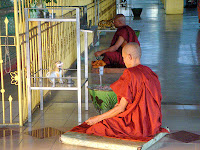I am decidedly ambivalent about the holiday season.
As a child I can remember being so excited that I was unable to sleep on Christmas Eve. Everything was so special -- the decorations at our house and around the city, the presents under the tree, the Christmas music on the radio and in the shopping malls, the heartwarming holiday specials on television, the dozens of Christmas cards we sent and received. Although my family wasn't devoutly religious, we usually attended midnight mass on Christmas Eve at our local Episcopalian church. Christmas day was a hectic family affair that started with opening presents, followed by dinner in mid-afternoon with in-laws and relatives, more exchanging and opening of gifts, then socializing until 8 or 9 o'clock. All in all this was a very intense and long day.
The next day was a big let down. I can remember getting together with neighborhood friends to compare gifts and to play with each other's stuff. But the big thrill was over and it seemed anticlimactic. Amazing what a difference 24 hours can make -- from heartfelt joy, eager anticipation, and warm fuzzy emotions to a kind of emptiness, deflation and a feeling of despondency. And those presents I had wanted so badly almost never lived up to my expectations.
As an adult I have to fight a tendency to become a bit depressed during the holiday season. It's not that I'm a Scrooge at heart -- I really would like to feel the holiday spirit and experience those warm fuzzies again. But it is hard to do when retailers start their holiday push even before Halloween, Christmas carols are used to sell merchandise rather than express holiday sentiments, and buying gifts is evaluated in terms of contribution to GNP rather than as a gesture of caring. It seems commercialized, shallow and insincere.
And of course it is hard to reconcile the messages of goodwill and peace with pervasive international conflict, and with the exploitation, denigration and ruthless subjugation of large segments of the global population. If we could act like it was Christmas Eve throughout the year these problems might disappear. But I fear we are more likely to act like it was the day after Christmas.
To end on a more positive note, and to illustrate my ambivalence, not just negativity toward the holidays, I'll offer this thought: maybe capturing the spirit of the season shouldn't be easy. Maybe the challenge of overcoming the obstacles, of seeing past the commercialism, conflict, and shallowness can lead to a more significant personal and social experience. I think it's worth a try.
As a child I can remember being so excited that I was unable to sleep on Christmas Eve. Everything was so special -- the decorations at our house and around the city, the presents under the tree, the Christmas music on the radio and in the shopping malls, the heartwarming holiday specials on television, the dozens of Christmas cards we sent and received. Although my family wasn't devoutly religious, we usually attended midnight mass on Christmas Eve at our local Episcopalian church. Christmas day was a hectic family affair that started with opening presents, followed by dinner in mid-afternoon with in-laws and relatives, more exchanging and opening of gifts, then socializing until 8 or 9 o'clock. All in all this was a very intense and long day.
The next day was a big let down. I can remember getting together with neighborhood friends to compare gifts and to play with each other's stuff. But the big thrill was over and it seemed anticlimactic. Amazing what a difference 24 hours can make -- from heartfelt joy, eager anticipation, and warm fuzzy emotions to a kind of emptiness, deflation and a feeling of despondency. And those presents I had wanted so badly almost never lived up to my expectations.
As an adult I have to fight a tendency to become a bit depressed during the holiday season. It's not that I'm a Scrooge at heart -- I really would like to feel the holiday spirit and experience those warm fuzzies again. But it is hard to do when retailers start their holiday push even before Halloween, Christmas carols are used to sell merchandise rather than express holiday sentiments, and buying gifts is evaluated in terms of contribution to GNP rather than as a gesture of caring. It seems commercialized, shallow and insincere.
And of course it is hard to reconcile the messages of goodwill and peace with pervasive international conflict, and with the exploitation, denigration and ruthless subjugation of large segments of the global population. If we could act like it was Christmas Eve throughout the year these problems might disappear. But I fear we are more likely to act like it was the day after Christmas.
To end on a more positive note, and to illustrate my ambivalence, not just negativity toward the holidays, I'll offer this thought: maybe capturing the spirit of the season shouldn't be easy. Maybe the challenge of overcoming the obstacles, of seeing past the commercialism, conflict, and shallowness can lead to a more significant personal and social experience. I think it's worth a try.






